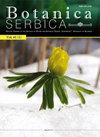Assessment of the botanical origin of Bulgarian honey samples using melissopalynological, DNA barcoding and NMR analyses
IF 1.1
4区 生物学
Q4 PLANT SCIENCES
引用次数: 0
Abstract
Polyfloral honey samples from Bulgaria were subject to parallel analyses of their botanical origin and composition using traditional melissopalynology, DNA barcoding based on the plastid rbcL gene and NMR analysis. The obtained datasets were compared with each other to evaluate the information capacity of the applied experimental methods. The results from the melissopalynological and DNA-barcoding studies demonstrated a significantly higher resolution of the latter, revealing the presence of pollen from a total of 17 plant families, 21 plant genera and 5 plant species in comparison to pollen from only 7 plant families, 3 plant genera and 4 plant species identified by melissopalynology. The higher resolution of DNA barcoding allows a more detailed characterisation of the diet and foraging preferences of honey bees, including foraging on plant species growing in lower abundance in the area. The comparison of the quantitative data on floral honey composition for several plant genera and species reveals significant differences between the relative abundance of the pollen grains estimated by melissopalynological analysis and the relative abundance of rbcL clones in rbcL libraries determined after DNA barcoding. All three applied methods confirm the polyfloral botanical origin of the analysed samples and support routine NMR use for the assessment of the floral origin of honey.评估保加利亚蜂蜜样本的植物来源,使用同源学,DNA条形码和核磁共振分析
对来自保加利亚的多花蜂蜜样品进行了植物来源和成分的平行分析,使用了传统的同源学、基于质体rbcL基因的DNA条形码和核磁共振分析。将得到的数据集相互比较,以评估所采用的实验方法的信息容量。dna条形码研究结果表明,后者的分辨率明显更高,发现了来自17个植物科、21个植物属和5个植物种的花粉,而仅来自7个植物科、3个植物属和4个植物种的花粉。DNA条形码的高分辨率可以更详细地描述蜜蜂的饮食和觅食偏好,包括在该地区生长较少的植物物种上觅食。通过对几种植物属、种的花蜜成分定量数据的比较,发现用花粉学方法测定的花粉粒相对丰度与DNA条形码法测定的rbcL文库中rbcL克隆的相对丰度存在显著差异。所有三种应用的方法都证实了分析样品的多花植物来源,并支持常规核磁共振用于评估蜂蜜的花来源。
本文章由计算机程序翻译,如有差异,请以英文原文为准。
求助全文
约1分钟内获得全文
求助全文
来源期刊

Botanica Serbica
Agricultural and Biological Sciences-Plant Science
CiteScore
1.40
自引率
12.50%
发文量
17
审稿时长
34 weeks
期刊介绍:
Botanica Serbica publishes original research papers on all aspects of plant, fungal and microbial biology research including the disciplines of microbiology, mycology, lichenology, bryology, flora, vegetation, biogeography, systematics, taxonomy, plant biotechnology, plant cell biology, plant ecology, environmental plant biology, forestry, genomics, horticulture, limnology, metabolomics, molecular biology, proteomics, virology, plant conservation and protection, and wildlife and ecosystem management.
 求助内容:
求助内容: 应助结果提醒方式:
应助结果提醒方式:


